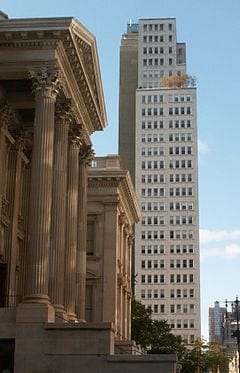
270 Broadway, looking west from Tweed Courthouse (Image by Americasroof at en.wikipedia [CC-BY-SA-3.0 (www.creativecommons.org/licenses/by-sa/3.0)], from Wikimedia Commons)
After reading a British report on atomic research and consulting with the “S-1 Committee” (the atomic committee), Vannevar Bush, the head of OSRD, recommended that the Army take over and move forward swiftly on the project. The Army Corps of Engineers created a special district for its headquarters in Manhattan that they blandly called the “Manhattan District” to keep its mission a secret. (Bird & Sherwin, 2005, p. 180; Groueff, 1967, p. 8). The project’s first office was at 270 Broadway on the 18th floor. (Broad, 2007).
The Manhattan Project benefited from this early location by being in a city with a busy commercial port. Edgar Sengier, president of the Belgian mining company Union Minière du Haut Katanga, heard that the Nazi government might confiscate his company’s uranium and in 1940 shipped 1200 tons from the Belgian Congo to a warehouse in Port Richmond, Staten Island. (Groueff, 1967, pp. 50-51; Broad, 2007). One of General Leslie Groves’s first acts after becoming head of the Manhattan Project in September 1942 was to purchase all of Sengier’s uranium and acquire a site in Oak Ridge, TN to process it. (Bird & Sherwin, 2005, pp. 184-185).
For further information about the legacy of Manhattan Project sites in the city, including environmental remediation, visit this page.
Back to NYC Nuclear Archive Home
Back to Invention of the Nuclear Bomb
Next Page: Research at Columbia University
By Catherine Falzone, 2012. Adapted from Nuclear New York archive with permission.
